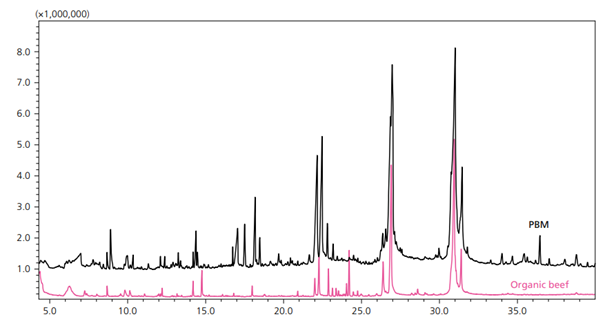
Panel discussion on...
Healthy lifestyle
Welcome in the world of alternative meat: analytical challenges and perspectives

Introduction
1) When looking at a healthy lifestyle, we are seeing consumers focusing on back-to-basic nutrition with an increase recognition of the paramount role that nutrition has on long-term overall wellbeing (1). Historically consumers have focused on their nutrition when they are seeking for a particular short-term health goal such as weight loss or building muscle mass (2). While this still exists, especially since COVID, consumers are taking a step further in looking at lifestyle, nutrition, and food supplements as tools to empower their autonomy in health (3)
When it comes to areas of focus, according to FMCG Gurus, (4) mental wellness is a key area ranking as the second most significant global health concern, following digestive wellbeing.
2) Although very difficult to mention just one achievement in 2023, the latest developments in weight management are undeniable, with the research and commercial success related with Glucagon-like peptide-1, (or GLP-1 for short) making weigh loss an achievable goal beyond willpower. The second most relevant area could be gut microbiome with the expansion of knowledge beyond probiotics in understanding the role of nutrition in modulating health in this area.
4) Consumers are more savvy than ever before when it comes to the product they buy, looking for value for money. According to FMCG Gurus survey from 2023, (5) the four (4) critical influencers shaping the perception of value in health products globally are taste, natural claims, scientifically proven claims, and multifunctional benefits.
5)How do consumers today judge their health status:According to FMCG Gurus survey from 2023, (6) consumers measure good health in the following rank– how fit and active consumers are, mental wellbeing, waistline, dietary habits and physical appearance.
6a) Capsules are still the most dominant format for dietary supplements globally. However, innovative formats such as gummies, liquids, chews are rising in which taste (a key influencer on perceive value for the customer) plays an important role.
6b) Data shows that the most common format used for product launches in the past 3 years globally are capsules (7). New formats have been adopted at different rates in the regions for example in the US gummies have been widely accepted and are the second most common format used in product launches. In Europe, for example, liquids and powders are getting traction in the market.
7a) From a profound shift in the focus on cognitive health to growing interest in the gut microbiome, 2024 year brings forward trends that reshape our approach to dietary supplementation.
FMCG gurus research (6) from 2023 shows that globally the top 5 areas that consumers want to improve are: sleep health, immunity, mental wellbeing and mood, digestive health and long-term health.
7b) We do see some regional variability. Although the top 5 concerns are common, their pool position may change when looking at it from a regional angle. As an example, in Europe and South America, immune health is the primary concern, in North America long-term health and mental well-being take the leading positions.
8b) Apps are one more tool withing the consumer journey of gaining autonomy and choice when it comes to their health. Apps are important when it comes to self-consciousness of the individual’s health status that is at their reach and in a easy to understand format that allows for a more educated and aware choice towards changes in lifestyles, nutrition and also food supplements.
10a)The shift toward sustainable and ethical practices in the dietary supplements industry reflects a growing concern for environmental impact and ethical implications. Consumers prioritize supplements with reduced carbon footprints, driving demand for sustainable sourcing practices, responsible harvesting, and organic and non-GMO ingredients.
10b) (Answered above)
10c) Yes. Kemin actively works to decrease carbon emissions, increase renewable energy use, and adopt sustainably sourced ingredients, aligning with industry initiatives for fair wages, safe working conditions, and ethical treatment of workers.
10d) At Kemin, we view sustainability as a journey instead of a destination. The journey will take us to where "sustainable" is an attribute of our products and processes. It is what we believe and practice.
Our global sustainability vision is to reach net zero GHG emissions by 2050. Our plans to reduce our emission through the increased use of renewable energy at our facilities and processes. This is being done through the addition of solar panels to our facilities across the globe and by purchasing renewable energy for our power use. Our biggest opportunity may be the ability to provide the most sustainable products in the world to our customers. Through conducting life cycle assessments to determine the environmental impact of products and considering sustainable components in project pipelines. Kemin looks to give our customers the most sustainable products.
What is required to scale-up production of alternative protein sources, such as lab-grown meat and cultivated (breast/bovine) milk?
For the production of 1 kg meat approx. 1 thousand times more water is needed than for 1 kg grain. And furthermore 60% of grain production in Germany is used for feeding cattle and pork.
The development of automated production equipment for tailor-made cultured meat using 3D bioprinting will help to feed the world (4).
The 3D bioprinting technology was developed by Professor Matsusaki of the Osaka University to create muscle tissue structures. This technology is expected to be utilized in the field of food, for production of cultured meat with controlled arrangement of muscle, fat, and blood vessels.
Most of the cultured meats reported so far have a minced structure consisting only of muscle cells, making it difficult to reproduce complex structures. To solve this problem, Matsusaki and co-workers developed a 3D bioprinting technology that uses 3D printing to produce different fibrous tissues (muscle, fat, and blood vessels) and integrates them into a bundle. This technology has made it possible not only to reproduce the famous Wagyu beef, but also to delicately adjust the fat and muscle components. Osaka University and Shimadzu will jointly develop equipment to automate the production of cultured meat using this technology. (5).
What are the most effective methods for enhancing the flavor and texture of alternative proteins?There are meaningful reasons not to go for these new types of foods
Bad experience in terms of taste and texture
Raw meat on its own has little aroma; therefore, almost all aromas associated with “meatiness” are created during the cooking process by the Maillard Reaction between amino acids and reducing sugars. That reaction determines which non-volatile precursors release volatile aroma compounds. Plant-based meat (PBM), products created to resemble animal meat in both look and taste, are growing in popularity. A plant protein such as soy protein concentrate, along with colors, stabilizers, and oils, is used to successfully mimic meat flavor and texture. And, just like in animal meat, the amino acids of that protein undergo the Maillard Reaction.
Samples of PBM were run with the solid phase microextraction GC-MS and the volatile profile was compared against that of the organic beef. Similar compounds, such as fatty acids and Maillard browning reaction products, were found in both types of meat (Figure 1).
The differences can be explained by the different and wide variety of precursors present in PBM since it contains amino acids and sugars from various sources as opposed to regular meat.
There are five basic tastes, including deliciousness, which are perceived by people. The amount and kind of amino acids contribute to taste components. Of all the amino acids, glutamic acid is widely known as a component of the delicious taste. Further, the types and component ratios of amino acids largely control the flavor of food products. For example, glycine and alanine are associated with sweetness, valine and leucine with bitterness, and aspartic acid and glutamic acid with deliciousness.
The texture of food, including the sense of crispness, springiness, firmness, and the feeling on the tongue, is an important element that together with taste has an impact on the deliciousness of food. Food texture is normally evaluated using sensory tests. However, sensory tests are often difficult to reproduce, due to individual differences in people’s sensations and physical condition.
A texture analyzer can support sensory test with objective results in the form of numerical values for use in the field of food development. The texture analyzer evaluates the texture characteristics and allows a comparison of the texture of plant-based meat (PBM) and, for instance, chicken meatballs. Compared to chicken-derived products, plant-based meatballs had a higher force under loading conditions with less elasticity, which is the property to restore deformation (6). It is consistent with the result of the sensory test.

Figure 1. Overlaid Representative Chromatograms for PBM (black) and Organic Beef (pink) (6).
Panelists
References and notes
- FMCG Gurus Top Ten Trends for 2024https://fmcggurus.com/top-ten-trends-for-2024/
- FMCG Gurus – Active Nutrition Vs Sports Nutrition in 2022 – Global Report https://fmcggurus.com/reports/fmcg-gurus-active-nutrition-vs-sports-nutrition-in-2022-global-report/
- https://www.sciencedirect.com/science/article/pii/S2667321523001427
- FMCG Gurus Navigating Cognitive Health and Wellness in 2023 - Global Report https://fmcggurus.com/reports/fmcg-gurus-navigating-cognitive-health-and-wellness-in-2023-global-report/
- FMCG Gurus – Herbal Remedies – Exploring Nature’s Healing – Global Report 2023 https://fmcggurus.com/reports/fmcg-gurus-herbal-remedies-exploring-natures-healing-global-report-2023/
- FMCG Gurus – Top Ten Trends for 2024 – Global Report https://fmcggurus.com/reports/fmcg-gurus-top-ten-trends-for-2024-global-report/
- Innova search conducted in 26/02/2024 in format per region in food supplements in the past 3 year
Questions
1.
2.
3.
4.
5.
How have consumer awareness & demands related to healthy lifestyle changed in the last 12 months?
Where do you see the greatest scientific achievement in nutritional sciences in the last 12 months?
Are there specific health benefit areas in which significant more clinical studies are being done than in others, comparing the last 3 years?
What are the key influencers driving consumer purchasing decision for supplements or health foods? Is substantiation of claims important?
How do consumer today judge their health status?
Please put the following parameter in order 1 highest priority 7 lowest priority:
- Physical Symptoms, like pain, fatigue, constipation, weight gain
- Fitness Levels: endurance, strength, flexibility,
- Health Tracking Devices and heart rate, sleep patterns, steps taken
- Diet and Nutrition: intake of fruits, vegetables, whole grains, proteins.
- Mental and Emotional Well-being: stress levels, emotional balance, happiness
- Quality of sleep: Sleep quality and duration
- Medical Check-ups: blood pressure checks, cholesterol screenings, blood sugar tests
6.
Delivery formats can support consumer compliance and underline the technology driven approach of the brand.
a.
b.
c.
Do you see a consumer trend in preferences for certain delivery formats?
Are delivery format preference a regional, cultural aspect like taste?
Do you see a trend to carry out ingredient clinical trials using a selected delivery format as study product formulation or are most clinical studies still done in capsules?
7.
Consumer health concerns can vary widely across different regions and demographics globally. However, several common health concerns tend to be prevalent across various countries and populations due to globalization, lifestyle changes, environmental factors, and access to information.
a.
b.
Which are the key global consumer health concerns?
Do you see regional differences?
8.
There is a significant increase in the availability of apps and digital platforms focused on healthy lifestyle, particularly to support personalized approaches to mental wellbeing, metabolic support, weight management and physical fitness.
a.
b.
c.
d.
Do you see lifestyle apps as competition for supplement brands?
Do you think that these apps help to educate consumers, being more targeted when searching for supplements?
Did you consider setting up a lifestyle app to promote your supplement or your ingredient?
Did you set up a lifestyle app to promote your supplement/ ingredient and can you explore about your experience and business impact?
9.
AI (Artificial Intelligence) algorithms are today offered for various aspects of clinical trials to proof efficacy of your health ingredient or supplement.
a.
b.
c.
d.
Are consumers looking for substantiation of claims through AI driven clinical trials?
Did you consider working with an CRO specialist in AI to investigate your health ingredient or supplement?
If you applied already AI methods during the discovers/ development of your health ingredient, please share your experience and recommendation with us.
Do you think that in 2030 AI will be a manifest tool for clinical trials?
10.
A healthy lifestyle may also involve a commitment to sustainable practices for both personal and planetary health. This could include supporting ethical and environmentally conscious products.
a.
b.
c.
d.
e.
Do you agree that sustainability has become a growing concern also in the nutraceutical industry?
Are consumer looking proactively for brands which have ethical and environmental principles?
Are you looking for ethically sourced raw materials, ingredients?
Did you implement measures to establish resource-efficient processes?
Are you developing socially useful products and how do you define it?
11.
What are the major geographical differences related to healthy lifestyle trends?
a.
b.
c.
d.
e.
What are the latest trends related to claims and product forms in China?
In the U.S.
In Mexico
How are claims and dosage forms differentiated in Europe? How does your company ensure compliance with health and safety regulations in Europe?
Do you have a country where you would like to speak about trends for products?
12.
Focus clinical studies. Overall, there has been a recognized push for more gender-inclusive, geographical, and target group focused clinical research. The same trend can be seen in clinical trials for supplements or functional foods.
a.
b.
c.
d.
Please select an area you are active in and let us know which is your hot topic ingredients for 2024 for this area, based on substantiated claim, parameters, biomarkers being studied and/ or clinical study being done. Please name ingredients by scientific name and composition and not by brand name.
Please select your geographical area:
Western (EU, USA)
Asia (China, Japan, Asia Pacific)
Americas (Middle and Latin America)
Kids development/ early life nutrition/infant in Western countries and AP
Adult nutrition and prevention of developing disease
Elderly nutrition and how to support quality of life during aging
Sports nutrition, within different life decades and activity levels
References and notes























